Supplemental Supporting Statement Part A for Substantive Change (Phase 3) September 2022
0218 - Substantive Change Request September 2022 - Supplemental Supporting Statement A for ARMS3 2022 - Sept 23, 2022.docx
Agricultural Resource Management and Chemical Use Surveys
Supplemental Supporting Statement Part A for Substantive Change (Phase 3) September 2022
OMB: 0535-0218
SUPPLEMENTAL SUPPORTING STATEMENT Part A
Agricultural Resource Management and Chemical Use Surveys
Substantive Change
OMB No. 0535-0218
This substantive change is being submitted as a supplemental supporting statement for including the 2022 Agricultural Resource Management Phase 3 Surveys (ARMS 3). This substantive change is to accommodate the addition of the 2022 ARMS 3 questionnaires.
In January, 2023, NASS will be conducting the 2022 Census of Agriculture (0535-0226) which has a mandatory reporting requirement. In addition, NASS will be conducting the 2022 Agricultural Resource Management Survey (ARMS) Phase 3 which has a voluntary reporting requirement. Both of these surveys collect whole farm data for the calendar year of 2022. The entire ARMS 3 sample is included in the Census of Agriculture population.
In order to reduce respondent burden, NASS previously created a combined questionnaire for the ARMS 3 surveys that contained the questions from the Census of Agriculture questionnaire with the unique questions asked by the ARMS 3 questionnaires. Farm operators who were willing to complete the longer ARMS 3 questionnaires did not need to complete the Census of Agriculture survey. NASS created a data set from the completed ARMS 3 questionnaire that fulfilled the reporting needs of the Census of Agriculture. NASS plans to do the same in 2023 for the operations that are sampled for the ARMS 3 surveys. There are two versions of the ARMS 3 questionnaire that will be used in 2023; one for the general Cost and Returns Report and one for the Wheat Cost and Returns Report. NASS conducted a combined general Cost and Returns Report and the Wheat Cost and Returns Report in 2018 (at this link: https://www.reginfo.gov/public/do/DownloadDocument?objectID=76238501).
Both versions will contain the questions from the Census of Agriculture questionnaire with the unique questions asked by the ARMS 3 questionnaires. The 2022 Cost and Returns Report is included in this submission. The Wheat Production Practice and Cost Report will include the Cost and Returns report with the following additional questions:
Followup questions to the following expenses in the production expenditures section (Section 32) with what amount was specifically for the wheat enterprise:
Seeds, sets, plants, seed cleaning and treatments, transplants, trees and nursery stock,
Nutrients, fertilizer, lime, and soil conditioners,
Agricultural chemicals and biocontrols for crops, livestock, poultry, and general farm use
All fuels, oils and lubricants,
Electricity expenses for irrigation,
Electricity expenses for drying,
Purchased water for irrigation,
Repairs, parts and accessories for motor vehicles, machinery and farm equipment,
Irrigation equipment & pump maintenance and repair expenses,
Federal crop insurance,
Cash wages to hired farm & ranch labor,
Payroll taxes for hired labor,
Benefits for hired labor,
Contract labor, and
Custom work,
The following wheat drying questions which will appear between Section 38 and 39:
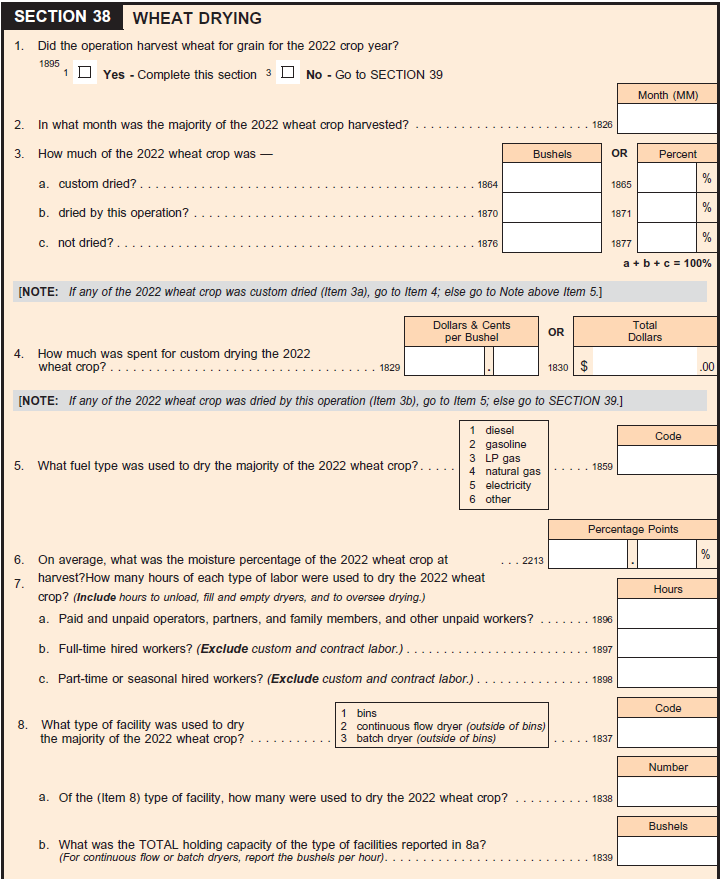
Farm operators who refuse to complete the voluntary ARMS 3 questionnaires will still be required to complete the mandatory Census of Agriculture. The 100 minutes that is currently approved for the ARMS 3 questionnaire along with the 50 minutes that is approved for the Census of Agriculture will be more than enough to cover the expanded questionnaire. If the operator refuses to complete the ARMS 3 questionnaire the 50 minutes for the Census burden will be used.
To reduce respondent burden the 2022 ARMS 3 questionnaires, the following changes will be made:
Land in Farm & Ranch Section – Questions Removed
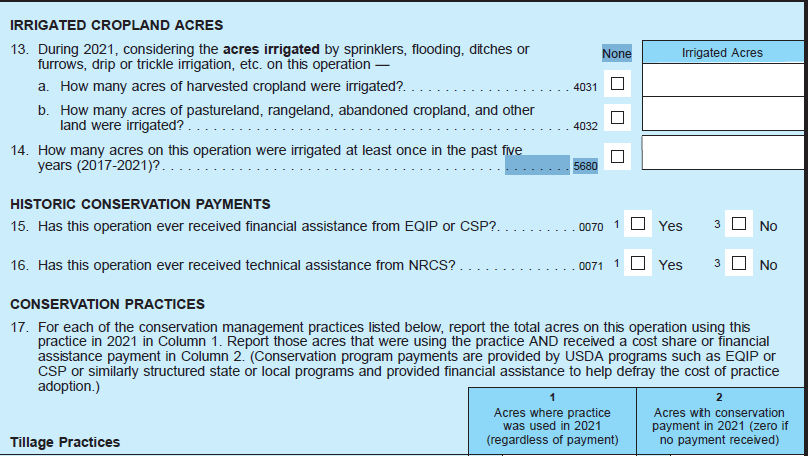
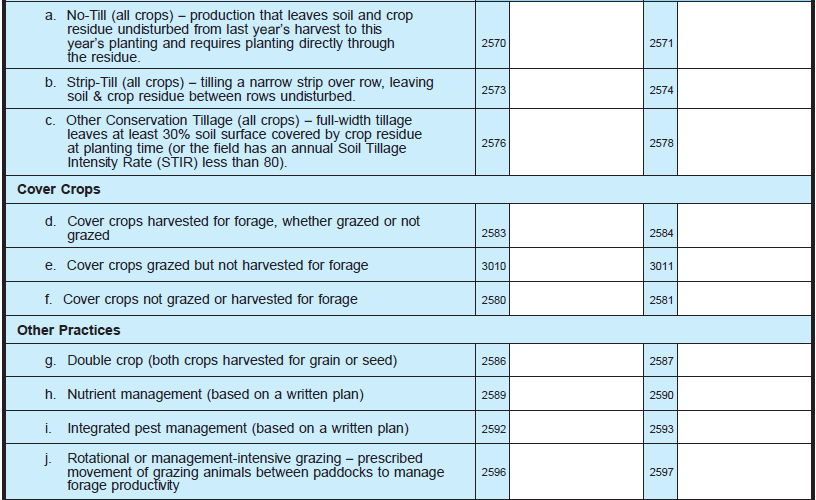
Marketing and Production Contract and Direct Sales Section – Questions Removed
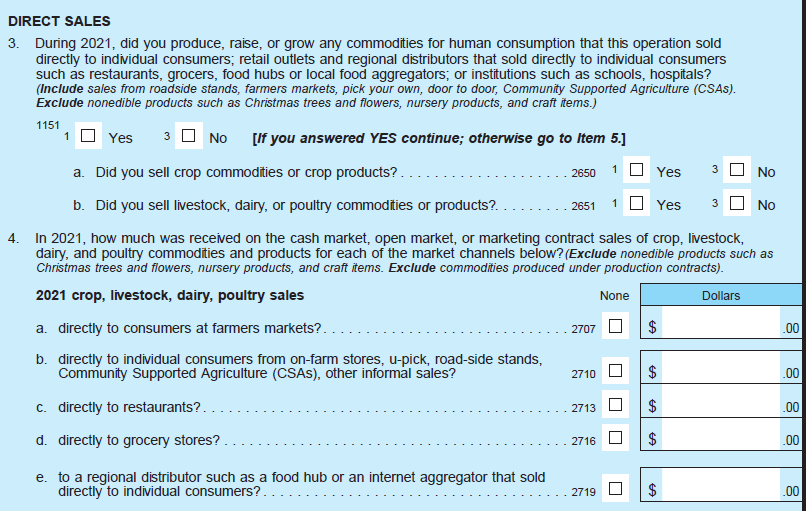
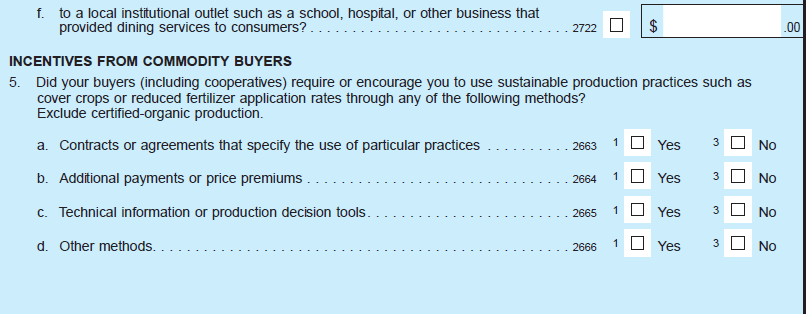
The Government Payments section has been reduced:
2021 2022
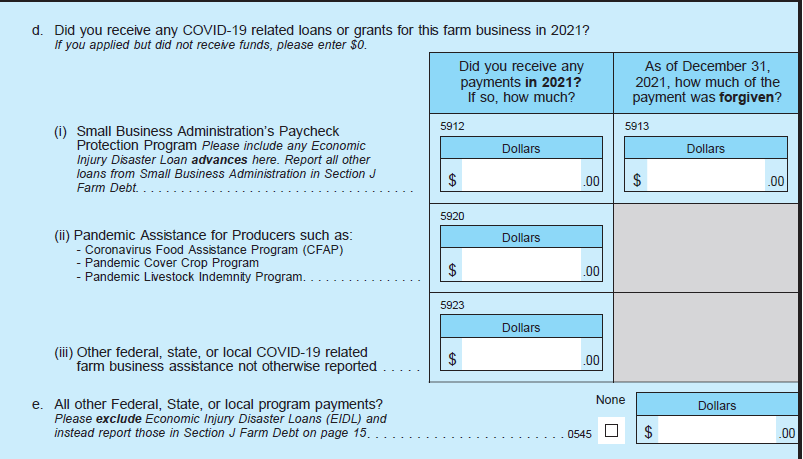

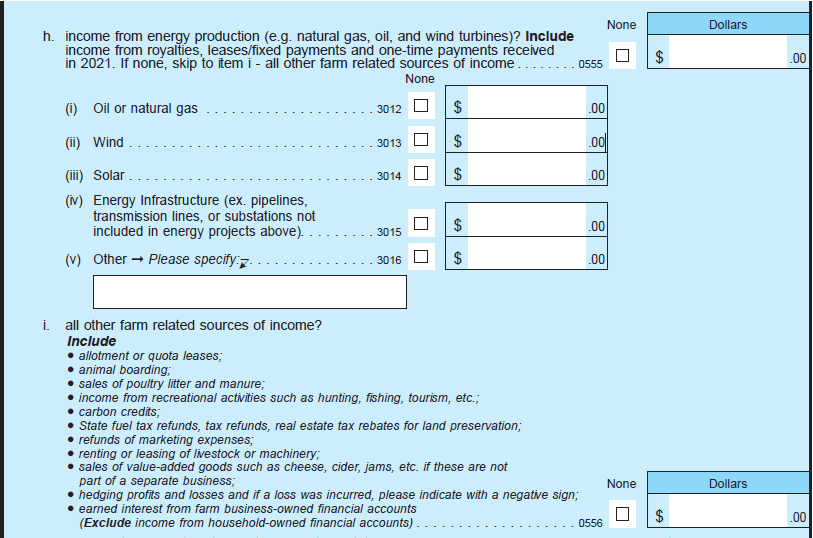
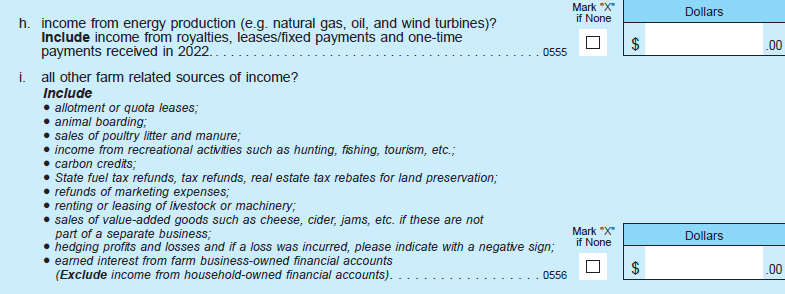
Government & Other Farm Related Income – Questions removed
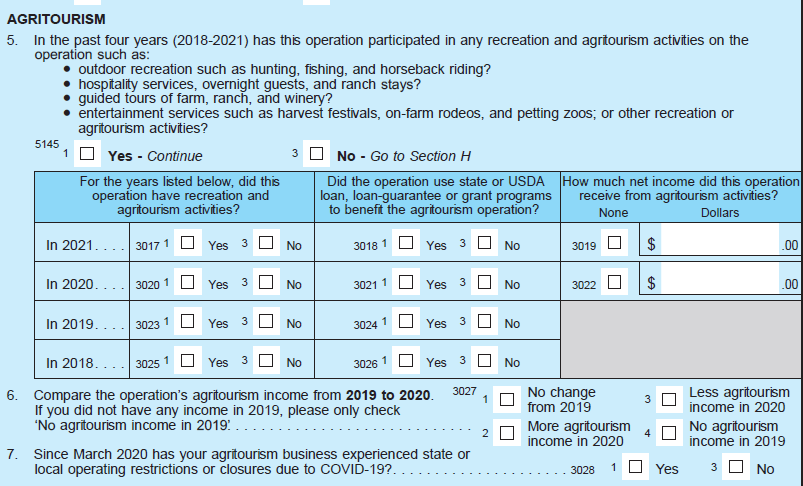
Operating & Capital Expenses Section
Added a percent for farm/ranch use to the ATV/Side by Side/UTV expenditures to more accurately record the farm expenditure for this item:

Personal Characteristics and Farm Management Section – Questions Removed
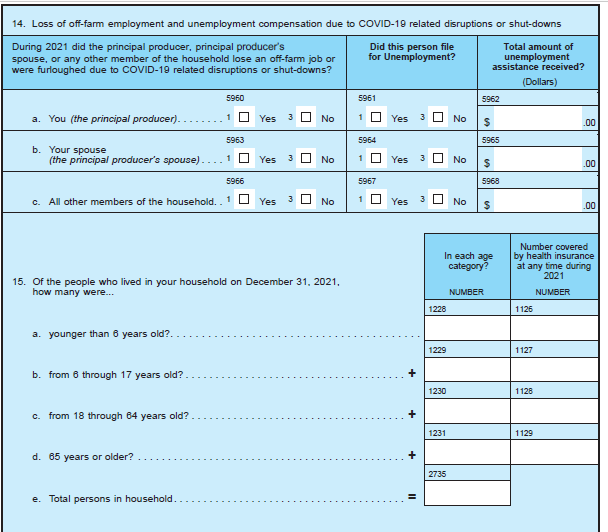
A. JUSTIFICATION
Circumstances making collection of information necessary.
NASS is requesting a substantive change to the ARMS and Chemical Use Survey docket (0535-0218) to accommodate the addition of the 2022 ARMS 3, questionnaires.
NASS conducts the ARMS program as a part of a cooperative agreement with the USDA Economic Research Service (ERS). The Costs and Returns (Phase 3) is the economic phase, in which we collect data related to the costs and returns for both the whole farm and for specific commodities raised on each farm. The specific commodity for 2022 is wheat which includes winter, Durum, and other spring wheat. The majority of the questions that are asked in the Phase 3 surveys are a part of the ARMS core program and rarely have any changes made to them.
Historically, the majority of the surveys that are conducted under this OMB approval have been conducted by personal interviews. During the pandemic, NASS made changes to our data collection efforts to accommodate social distancing. If the current situation of the pandemic allows, NASS will resume personal interviewing using the National Association of State Department of Agriculture (NASDA) enumerators to collect the data. The surveys have been changed to allow for data collection by computer assisted web interviews (CAWI) and computer assisted telephone interviews (CATI). At this time, NASDA approved limited face to face enumeration by first phoning operators to schedule interviews and obtaining approval from the operator to engage in-person.
The substantive change request approved May 31, 2022 documents the plan to add additional samples to the Phase 3 in response to the Biden Administration’s top priority of advancing equity for all Americans. As stated by the White House, “President Biden is putting equity at the center of the agenda with a whole of government approach to embed racial justice across Federal agencies, policies, and programs.” (Retrieved March 15, 2022, from https://www.whitehouse.gov/priorities/.) The U.S. Department of Agriculture (USDA) is contributing to the President’s agenda by making racial justice and equity one of the top USDA priorities (Retrieved March 15, 2022, from https://www.usda.gov/media/radio/weekly-features/2021-02-09/what-are-tom-vilsacks-priorities-usda).
To review, the 2022 ARMS and Chemical Use Survey Cycle is

How, by whom, and for what purpose information is to be used.
There are no changes from the original approval for the purposes of the information collected.
Use of improved information technology.
Due to the COVID-19 pandemic and the need for social distancing, NASS added a Computer Assisted Telephone Interview (CATI) instrument with this particular group of surveys. In addition, NASS will be offering the ARMS 3 surveys as a Computer Assisted Web Interview (CAWI). NASS has also been developing a Computer Assisted Personal Interview (CAPI) instrument that will be available for use if it is safe to interview farmers in person.
NASS is beginning to implement electronic mail (e-mail) reminders with a link to for the respondent to complete the survey online. E-mail reminders will be used for respondents who opted-in to receiving E-Mail reminders.
4. Efforts to identify duplication.
There are no changes from the original approval related to duplication reduction.
Methods to minimize burden of small businesses.
With the use of the CATI, CAPI, and CAWI instruments, the incorporated screening questions and skip patterns should help minimize burden as much as possible.
Consequence if information collection were less frequent.
There are no changes to the frequency of these surveys than was originally approved.
Special circumstances.
No special circumstances are associated with this information collection.
Federal register notice and consultation with outside persons.
Not applicable.
Payments or gifts to respondents.
No payments or gifts will be given to respondents.
Confidentiality provided to respondents.
Confidentiality will be provided to respondents in accordance with the Confidential Information Protection and Statistical Efficiency Act of 2018, Title III of Pub. L. No. 115-435, codified in 44 U.S.C. Ch. 35 and other applicable Federal laws. All confidentially protections that are applied to all products released from these surveys will remain the same as originally approved.
Questions of a sensitive nature.
No questions of sensitive nature will be asked.
12. Hour burden and annualized costs to respondents.
This substantive change requests no change in burden from the approved 291,060 responses and 109,277 hours.
Table 1

Table 2

Cost to the public for completing the questionnaire is assumed to be comparable to the hourly rate of those requesting the data. Using a fully-loaded wage of $36.97 per hour, the adjusted overall cost to the public for the 109,277 hours is estimated at $4,039,970.70.
NASS uses the Bureau of Labor Statistics’ Occupational Employment Statistics (most recently published on March 31, 2021 for the previous May) to estimate an hourly wage for the burden cost. The May 2020 mean wage for bookkeepers was $21.20. The mean wage for farm managers was $36.93. The mean wage for farm supervisors was $25.25. The mean wage of the three is $27.79. To calculate the fully loaded wage rate (includes allowances for Social Security, insurance, etc.) NASS will add 33% for a total of $36.97 per hour.
Total annual cost burden to respondents.
No start-up or ongoing operation/maintenance costs are associated with this information collection.
Annualized costs to federal government.
There are no changes to the total annual cost of $18,500,000 documented in the change request approved May 31, 2022 for the Agricultural Resource Management Surveys and the Chemical Use programs.
Reasons for changes in burden.
There is no change in burden with this change request.
Tabulation, analysis, and publication plans.
The changes to the questionnaires will be incorporated in the publications that are listed in the original approval docket.
Request for approval of non-display of expiration date.
No request is being made for approval of non-display of the expiration date.
18. Exceptions to certification statement.
No exceptions to the certification statement are requested.
September 2022
| File Type | application/vnd.openxmlformats-officedocument.wordprocessingml.document |
| Author | HancDa |
| File Modified | 0000-00-00 |
| File Created | 2022-10-06 |
© 2025 OMB.report | Privacy Policy